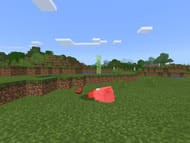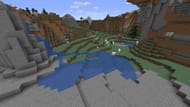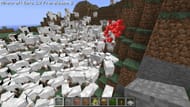- Create Wiki Page
- All Pages

Minecraft has a wide range of mobs that are based on real-life creatures. Cows, sheep, pigs, horses, and a variety of other animals can be found in-game. Sheep are one of Minecraft's most well-known mobs. These bleating creatures can be found in almost any biome that uses grass blocks to generate.
They spawn in groups of two to three when the light level is seven or higher. In Minecraft, sheep are the best source of wool and mutton. In Minecraft, players can dye sheep to make them into any colour they want, and there are 16 different types of sheep. Each sheep produces wool of the colour that it represents.
| Health points | 8 |
| Behavior | Passive |
| Hitbox size | Adult: Height: 1.3 Blocks | Width: 0.9 Blocks Baby: Height: 0.65 Blocks | Width: 0.45 Blocks Note that one block is one meter. |
| Spawn | Grass blocks with at least two block spaces above them. |
| Items usable on | Lead | Shears | Wheat | Dye |

The majority of sheep that spawn naturally are white, with a probability of 81.9%. The light grey, grey, and black sheep each have a 5% chance of spawning. Brown sheep have a 3% chance of spawning, while pink sheep have a very small chance of naturally spawning (0.164%colourhaveBehaviour5% of the sheep spawn as babies.
Groups of 2 to 3 sheep spawn on grass blocks at the surface at a light level of 7 or higher with at least 2 block space above, except in snowy tundras and wooded badlands plateaus during the world generation. Some sheep, however, may also spawn in shepherd houses, butcher houses, and animal pens in villages.

Upon being killed a sheep drops:
Upon being sheared:
Upon successful breeding, 1–7 EXP is dropped. Note that killing a lamb yields no items nor experience.
Do not kill a sheep for wool because you can get more by shearing

Sheep are mostly unconcerned about other mobs, especially unconcerned about wolves. Sheep can follow a player keeping wheat for 6 blocks, but once outside of this range, they will stop following the player. They are usually found in small flocks of 2-4 sheep wandering; nonetheless, some sheep can be found alone.
Sheep normally avoid cliffs and hazardous areas. They bleat in a variety of patterns, but especially when they are threatened. Sheep run for a few seconds if they are injured, but they make no special effort to escape wolves.
Sheep transform grass blocks into dirt blocks by eating them. They can even eat a block's fern causing it to vanish. Sheep will eat grass from within minecarts and through blocks that are less than a full block thick, including honey blocks.
Sheared sheep's wool regrows when they eat a grass block, grass, or fern. As a result, if there is no grass available, a sheared sheep would not be able to regrow its wool. If an adult sheep has the chance, it has a 1 in 1000 chance of eating grass per game tick.

Wool is a block obtained from sheep that can be dyed in any of the 16 different colours, which are white, orange, magenta, light blue, yellow, lime, pink, grey, light grey, cyan, purple, blue, brown, green, red, and black. It’s worth mentioning that unlike blocks such as terracotta, there is no undyed wool variant. Wool blocks are weak, highly flammable, and offer little resistance against explosions. Their primary usage is as a decorative block.
Sheep's wool can be dyed by holding some dye and pressing the use key or the interact button. However, sheared sheep can't be dyed until after their wool has grown back for which they've eaten a grass block. Note that the colour of the sheep's wool is permanently changed by dyeing, or before the sheep is dyed again. Lambs will inherit the new colour of wool.
When a sheep is dyed and then sheared, the dyed wool colour is retained until the wool regrows. Regardless of their true colour, the wool patches on a sheared sheep still appear white. The patches retain the colour of the original dye.
If a sheep is named jeb_, its wool will change intermittently through all dye colours in a similar way to Prismarine. This is merely an aesthetic effect and upon being sheared or killed, the wool remains the same colour. Learn more about this effect and how to apply it in this guide.
Evoker effect
The following effect is a reference to a monk unit that can be found in the Age of Empires. For this to take effect in-game, an evoker (a type of Illager) shouldn't be engaged in battle and the /gamerule mob griefing should be set to true, then only will the evoker be able to change the colour of all the sheep's wool within 16 blocks to blue. This spell is activated when the evoker makes a "wololo" sound and produces orange-coloured particles.

Sheep can be bred with wheat and upon doing so gives birth to a lamb. Following the birth of the baby sheep, it cannot breed for about 5 minutes. If the parents' wool colours are compatible, the resulting lamb inherits a combination of their colours an example can be a light blue baby sheep produced by white and blue sheep as parents. Otherwise, the baby sheep spawns with the same colour as one of the parents, chosen at random.
The inheritance of wool colour is not affected even if one of the parents are sheared. Wheat will help baby sheep, which normally takes 20 minutes to mature, to develop a little faster. Each usage reduces the amount of time it has left to grow up by 10%. It can also help itself grow faster by consuming grass.
| Achievement | In-game description | Actual requirements (if different) |
| Rainbow Collection | Gather all 16 colours of wool. | All the colours of wool must have been picked up by the player at least once but do not necessarily have to be in the inventory at the same time. |
Q. What is the rarest colour of sheep in Minecraft?
Out of all different sheep, pink sheep are the rarest in Minecraft with a spawning probability of 0.164%.
Q. What does Dinnerbone do in Minecraft?
Any mob, apart from the exception of Ender Dragon, named "Dinnerbone" or "Grumm" (case sensitive) through name tags, commands, or any other method, will cause it to render upside-down. Nevertheless, the behaviour of the mob does not change.
Q. Can animals starve in Minecraft?
No, cows, sheep or other animals cannot starve, let alone die by it. Some of them likely suffocate after colliding with a wall, but they cannot starve to death.